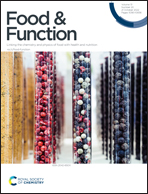Probiotic coated with glycol chitosan/alginate relieves oxidative damage and gut dysmotility induced by oxytetracycline in zebrafish larvae†
Abstract
Probiotic-based therapy is a promising approach, which can positively modulate bacterial composition and maintain homeostasis. However, exogenous probiotics are easily destroyed by harsh conditions in vivo; thus, their application prospects have been severely limited. Specifically, oxytetracycline (OTC), a broad-spectrum antibiotic widely used in aquaculture, results in adverse intestinal environments, such as dysbacteriosis, oxidative damage, and gut dysmotility. Here, we describe a facile method to apply glycol chitosan/alginate as armor on the surface of probiotics to effectively protect them from the changed enteric environments induced by OTC. The results demonstrated that the coated Lacticaseibacillus rhamnosus GG (LGG) for only 2 h administration could significantly improve the colonization rate of LGG, and the relative abundance of Lacticaseibacillus can reach 80% in OTC-treated larvae intestines. We also explored the specific mechanisms of the coated LGG to diminish reactive oxygen species (ROS) generation and rescue gut dysmotility for OTC treatment, including enhancing the activity of antioxidative enzymes (CAT, SOD and GPx) and increasing 5-HT synthesis. The mitigation effect of the coated LGG for 2 h administration was comparable to that of uncoated LGG for 24 h administration. Encapsulation of LGG with polysaccharides provides a unique application example for generating useful bacterial therapeutics in harsh intestinal environments.



 Please wait while we load your content...
Please wait while we load your content...